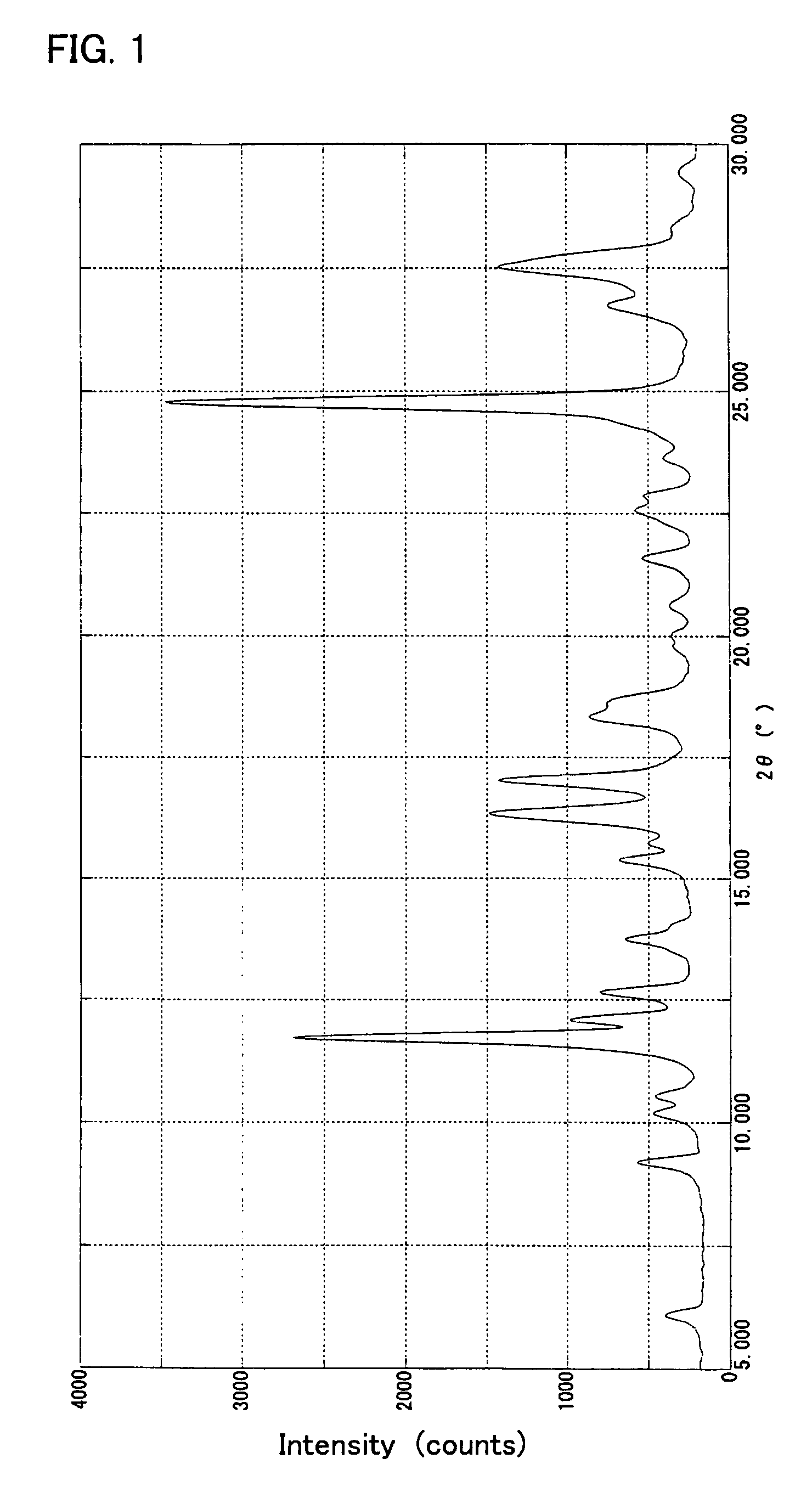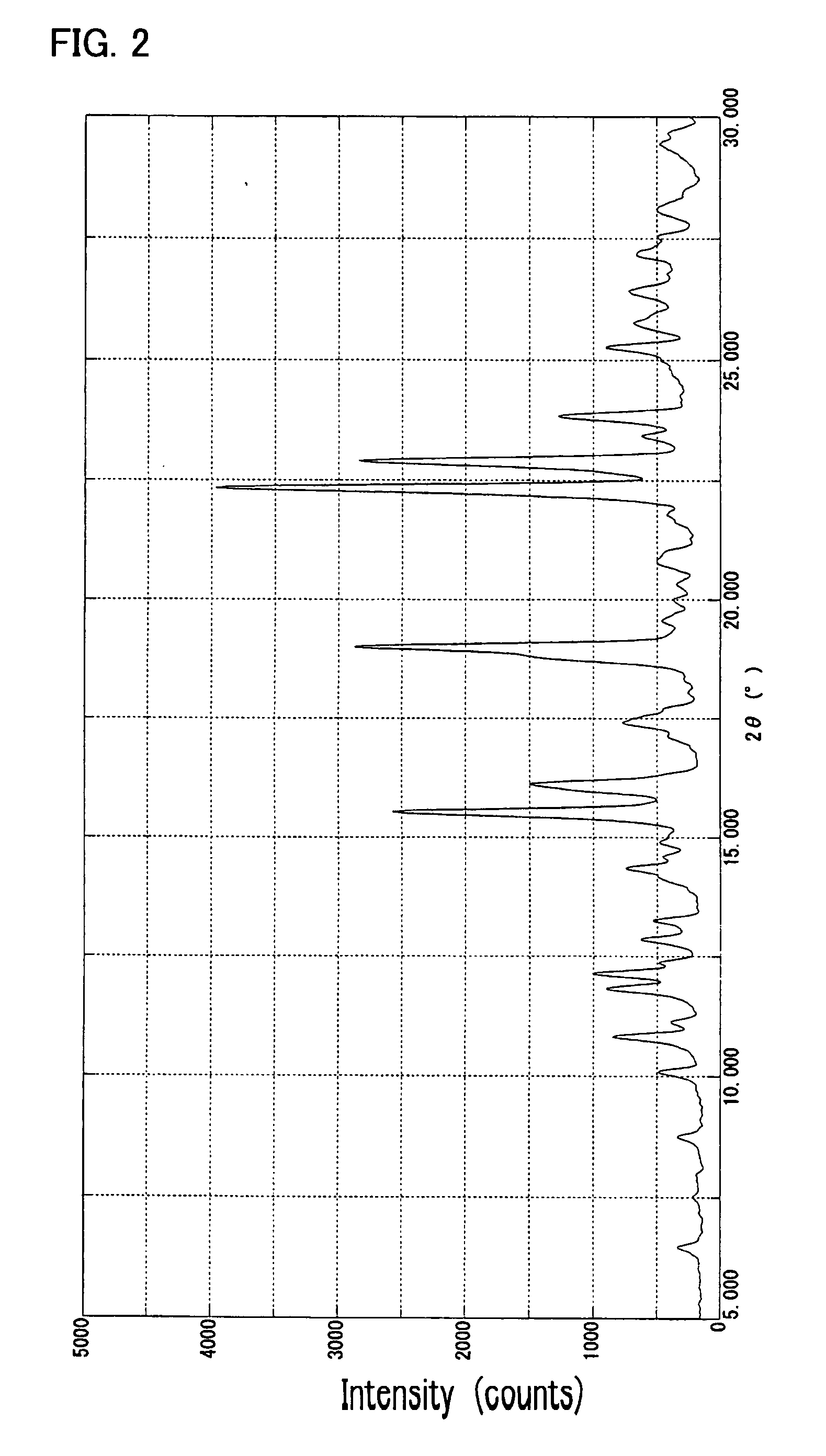Nonsolvate-Form Crystal of Polymethine Compound, Process for Producing the Same and Use Thereof
a nonsolvate-form crystal and compound technology, applied in the field of new nonsolvate-form crystals of polymethine compounds, can solve the problems of undesirable use of raw materials for commercial scale production, limited type or kind of compounds, and inability to meet such requirements of polymethine compounds, etc., to achieve high gram extinction coefficient, stable solution, and high purity
- Summary
- Abstract
- Description
- Claims
- Application Information
AI Technical Summary
Benefits of technology
Problems solved by technology
Method used
Image
Examples
example 1
Production of the α Crystal Modification of the Nonsolvate-Form Crystal of Polymethine Compound
[0100] To 150 ml of acetone was added 15.03 g of a polymethine ether compound represented by the formula (II) (R═CH3), and 6.00 g of p-toluenesulfonic acid monohydrate was added to the mixture with stirring at 25-30° C. The resulting mixture was stirred at that temperature for 1 hour and then heated to a temperature of 50-55° C., and 68 ml of ethyl acetate was added dropwise. After 1 hour of stirring at the same temperature, the mixture was cooled to 15-20° C. The resulting crystalline precipitate was collected by filtration, washed with ethyl acetate and then dried to give 16.21 g of the α crystal modification of the compound of formula (I).
[0101] This crystal showed a solubility of not lower than 15% in each of methanol and ethanol. The elemental analysis data, melting point (decomposition temperature), absorption maximum wavelength (λmax) and gram extinction coefficient (εg) of this c...
example 2
Production of the β Crystal Modification of the Nonsolvate-Form Crystal of Polymethine Compound
[0108] The α crystal modification (10.00 g) obtained in Example 1 was added to 100 ml of water at 40-45° C., the mixture was stirred at the same temperature for 1 hour, and the precipitate was collected by filtration, washed with water and dried to give 9.58 g of the β crystal modification of the compound of formula (I).
[0109] This crystal showed a solubility of not lower than 15% in each of methanol and ethanol. The elemental analysis data, melting point (decomposition temperature), absorption maximum wavelength (λmax) and gram extinction coefficient (εg) of this crystal were as follows.
[0110] Elemental analysis (C38H41ClN2O3S): MW=641.3
CHNCalculated (%)71.176.444.37Found (%)71.016.484.33
[0111] Melting point (° C.): 201-203° C. (decomposition)
[0112]λmax: 808 nm (diacetone alcohol solution)
[0113]εg: 4.41×105 ml / g·cm
[0114] A powder X-ray diffraction pattern of the crystal obtained is...
example 3
Production of the γ Crystal Modification of the Nonsolvate-Form Crystal of Polymethine Compound
[0117] To 165 ml of methanol was added 15.03 g of a polymethine ether compound represented by the formula (II) (R═CH3), and 6.00 g of p-toluenesulfonic acid monohydrate was added to the mixture with stirring at 25-30° C. The resulting mixture was stirred at that temperature for 1 hour, and 165 ml of water was added dropwise. After 1 hour of stirring at the same temperature, the mixture was cooled to 15-20° C. The resulting crystalline precipitate was collected by filtration, washed with water and then dried to give 18.04 g of the γ crystal modification of the compound of formula (I).
[0118] This crystal showed a solubility of not lower than 15% in each of methanol and ethanol. The elemental analysis data, melting point (decomposition temperature), absorption maximum wavelength (λmax) and gram extinction coefficient (εg) of this crystal were as follows.
[0119] Elemental analysis (C38H41ClN...
PUM
| Property | Measurement | Unit |
|---|---|---|
| wavelength range | aaaaa | aaaaa |
| TG- | aaaaa | aaaaa |
| 2θ±0 | aaaaa | aaaaa |
Abstract
Description
Claims
Application Information
 Login to View More
Login to View More - R&D
- Intellectual Property
- Life Sciences
- Materials
- Tech Scout
- Unparalleled Data Quality
- Higher Quality Content
- 60% Fewer Hallucinations
Browse by: Latest US Patents, China's latest patents, Technical Efficacy Thesaurus, Application Domain, Technology Topic, Popular Technical Reports.
© 2025 PatSnap. All rights reserved.Legal|Privacy policy|Modern Slavery Act Transparency Statement|Sitemap|About US| Contact US: help@patsnap.com



